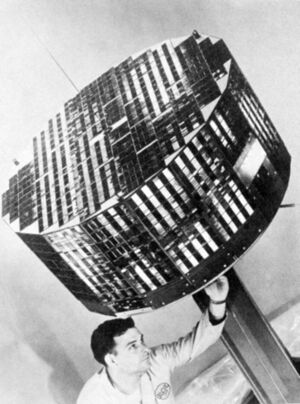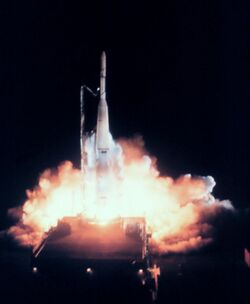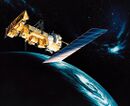Engineering:TIROS-2
 TIROS-2 before launch | |
| Mission type | Weather satellite |
|---|---|
| Operator | NASA[1] |
| Harvard designation | 1960 Pi 1 |
| SATCAT no. | 63 |
| Mission duration | 376 days |
| Spacecraft properties | |
| Spacecraft type | TIROS |
| Manufacturer | RCA Astro GSFC |
| Launch mass | 127 kilograms (280 lb)[2] |
| Start of mission | |
| Launch date | November 23, 1960, 11:13:03 UTC[3] |
| Rocket | Thor DM-19 Delta |
| Launch site | Cape Canaveral Air Force Station LC-17A |
| End of mission | |
| Last contact | December 4, 1961 |
| Decay date | May 2014 |
| Orbital parameters | |
| Reference system | Geocentric |
| Regime | Low Earth |
| Semi-major axis | 6,755.43 kilometers (4,197.63 mi) |
| Eccentricity | 0.0014596 |
| Perigee altitude | 374 kilometers (232 mi) |
| Apogee altitude | 394 kilometers (245 mi) |
| Inclination | 48.51 degrees |
| Period | 92.09 minutes |
| Epoch | December 8, 2013, 11:58:18 UTC[4] |
| Instruments | |
| Widefield Radiometer Scanning Radiometer Television Camera System | |
TIROS | |
TIROS 2 (or TIROS-B) was a spin-stabilized meteorological satellite. It was the second in a series of Television Infrared Observation Satellites. It re-entered in May 2014.[5]
Spacecraft
Tiros-2 was an 18-sided right prism, 107 cm in diameter and 56 cm high,[2] with 9,260[1] 1 by 2 cm silicon solar cells covered the top and sides. Five small directly opposed pairs of solid-fuel thrusters maintained a spin of 8 to 12 rpm.[2] For attitude control, the spacecraft used an infrared horizon sensor[1] and an magnetic attitude control device, made of 250 cores of wire wound around the outer surface, which oriented the spin axis to a 1 to 2 degree accuracy.[2] It also had a direction indicator for picture orientation.[1]
The satellite had two independent television camera subsystems, one low-resolution and one high-resolution, for taking pictures of cloud cover. Each camera had a magnetic tape recorder for storing photographs while out of range of the ground station network.[1] It also had a five-channel medium-resolution scanning radiometer and a two channel non-scanning low resolution radiometer for measuring radiation from the earth and atmosphere.[2]
Launch
File:1960-11-24 Tiros II Weatherman Satellite.webm TIROS 2 was launched on November 23, 1960 at 11:13:03 UTC, by a Thor-Delta rocket from Cape Canaveral, Florida. The spacecraft functioned nominally until January 22, 1962. The satellite orbited the Earth once every 98 minutes, at an inclination of 48.5°. Its perigee was 609 kilometers (329 nmi) and apogee was 742 kilometers (401 nmi).
The spacecraft functioned nominally until January 22, 1961.
Instruments
TIROS 2 added two infrared radiometers to TIROS 1 instruments, which allowed more analysis of frontal zones.[6]
References
- ↑ 1.0 1.1 1.2 1.3 1.4 "TIROS". NASA. https://science.nasa.gov/missions/tiros.
- ↑ 2.0 2.1 2.2 2.3 2.4 "TIROS 2". National Space Science Data Center. https://nssdc.gsfc.nasa.gov/nmc/spacecraft/display.action?id=1960-016A. Retrieved January 15, 2023.
- ↑ McDowell, Jonathan. "Launch Log". Jonathan's Space Page. http://planet4589.org/space/log/launchlog.txt. Retrieved December 8, 2013.
- ↑ "TIROS 2 Satellite details 1960-016A NORAD 63". N2YO. December 8, 2013. http://www.n2yo.com/satellite/?s=63. Retrieved December 8, 2013.
- ↑ "TIROS 2". http://www.aerospace.org/cords/reentry-predictions/upcoming-reentries-2014/1960-016a/.
- ↑ Hawkins, R. S. (October 1, 1964). "Analysis and Interpretation of TIROS II Infrared Radiation Measurements". Journal of Applied Meteorology 3 (5): 564–572. doi:10.1175/1520-0450(1964)003<0564:aaioti>2.0.co;2. ISSN 0021-8952. Bibcode: 1964JApMe...3..564H.
 |



